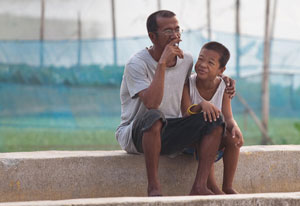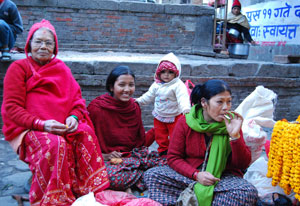Fogarty considers evolving global tobacco landscape
November / December 2013 | Volume 12, Issue 6

Photo by Stephen Russell Keith G. Valera/Photoshare
Fogarty's tobacco program has built research skills and
infrastructure in developing countries, where tobacco
use is rising, particularly among women and children.
By Cathy Kristiansen
Global efforts to curb tobacco use and secondhand smoke exposure have increased sharply in the past decade, but so has the problem - now one person dies every six seconds because of tobacco, according to WHO data. Alarmingly, new usage patterns are emerging, with women, young people and developing country populations taking up tobacco at increasing rates.
Low- and middle-income countries (LMICs), where tobacco use is rising fastest, include those least equipped to tackle the associated health burdens from cancer, cardiovascular conditions, and other disease and disability. Many LMICs lack epidemiological data on their population's tobacco use and resulting costs in terms of health care and lost productivity. Consequently, they are not planning preventive action. This prompted Fogarty to establish the International Tobacco and Health Research and Capacity Building Program in 2002. After a decade of investments, Fogarty is reviewing progress and considering new directions.
Fogarty's program has two distinct approaches: supporting observational intervention and policy research, as well as building capacity in fields such as epidemiology, behavior, prevention, treatment, implementation science and health services. Like many Fogarty initiatives, it partners LMIC and U.S. scientists, and emphasizes training and capacity building - the foundations of a robust research infrastructure.
"Our support has helped generate tobacco research capacity in many countries that had minimal or no quality data," said Fogarty Director Dr. Roger I. Glass. "Establishing reliable epidemiological information is essential if countries are to develop a tobacco control program that will be cost-effective and have an impact on their at-risk populations."
Fogarty recently led an evaluation of the Tobacco program and found it has made "significant scientific advances" in contributing to tobacco control. It fueled collaborations among investigators in more than 30 countries, trained at least 3,500 individuals and contributed to the publication of over 415 scientific papers.
A number of program participants have reached leadership positions in their home countries, facilitating communication between researchers and policymakers and broadening recognition of the health burden from tobacco use. In Cambodia, for example, one grantee became an in-country WHO tobacco control representative and in Laos, another became a finance ministry coordinator of the Southeast Asian Initiative on Tobacco Tax.
Amassing data and developing skills
Projects have covered a wide range of topics, including study of behavioral, susceptibility and risk interventions, for instance counseling pregnant women in Argentina to avoid smoking. Other common topics have involved epidemiology and policy research, such as generating data on tobacco and cancer in Kenya. A few projects have examined economics, including strategies the tobacco companies are using to promote products in Africa.

Photo courtesy of Campaign for
Tobacco-Free Kids
Tobacco use has been rising in developing
countries, especially among women.
Several grantees investigated tobacco use among young people and women. India faces a major problem with youth smoking, especially of cheap hand-rolled cigarettes. With Fogarty support, Indian and University of Texas researchers studied poor communities in New Delhi and found that a school-based intervention successfully curbed tobacco use rates in adolescents, especially among girls and the youngest students. But the study also underscored the need for additional approaches.
Another collaboration examined a habit that is common in the Middle East and increasingly popular among U.S. college students who believe it to be safer than cigarettes - hookah, or water pipe, smoking. Researchers in Jordan and at the Virginia Commonwealth University examined the urine of Jordanian students after hookah smoking and found plenty of toxins, including higher levels of carbon monoxide, benzene and other carcinogens than yielded by cigarettes. These findings can inform researchers elsewhere in the region, as well as in the U.S.
One novel Fogarty project looked at how technology can help people quit their tobacco addiction. Researchers in Turkey, in collaboration with the nonprofit Internet Solutions for Kids, devised culturally relevant text messages to encourage participants to maintain their smoking cessation plan. A follow-up study showed the messages helped people stick to their resolve. These findings can be applied to other mHealth efforts to spur behavior change.
Tobacco use weighs heavily on world
If current trends continue, tobacco use will kill 1 billion people this century, according to the 2012 Global Adult Tobacco Survey. The following additional data come from the WHO, which is calling on countries to urgently adopt comprehensive tobacco control policies, and the Institute for Health Metrics and Evaluation.
- Tobacco kills up to half its users.
- Tobacco kills nearly 6 million people each year, more than 5 million stem directly from tobacco use and more than 600,000 from secondhand smoke.
- Based on current trends, the annual death toll could rise above 8 million by 2030.
- Globally, nearly 40 percent of men and 9 percent of women smoke.
- Nearly 80 percent of the world's 1 billion smokers live in low- and middle-income countries.
- Consumption of tobacco products is increasing globally, though it is decreasing in some high-income and upper middle-income countries.
- Tobacco use accounts for more than half a trillion dollars of economic loss.
Sources: WHO publications on tobacco and IHME
As data generated by Fogarty's program mounts, some governments have responded by adopting or strengthening policies aimed at curbing tobacco use. For instance, in Hungary - which has one of the highest smoking rates in Europe - Fogarty-funded studies generated information about smoking patterns for consideration by government officials. Hungary later raised its tobacco sales tax and passed national clean air laws to reduce secondhand smoke exposure. A Fogarty project in China likewise produced data that helped shape a government policy to ban smoking in railways and airports.
Building on strong foundations
Despite the progress made, many LMICs still lack enough research capacity, data, expertise, policies and other resources to implement sufficient action. As the Fogarty program review noted, in developing countries, "government funding still pales in comparison to the enormity of the tobacco-use epidemic," and tobacco products continue to gain popularity around the world.
To consider these needs, Fogarty's Center for Global Health Studies (CGHS), along with NIH partners, held a workshop in June. Leaders in tobacco research, current and former grantees and LMIC policymakers discussed gaps, opportunities and emerging new priorities in tobacco-related research and training. The group plans to publish a scientific roadmap to guide tobacco control efforts.
At a recent Fogarty board meeting where tobacco issues were discussed, Dr. Nora D. Volkow, Director of the National Institute on Drug Abuse (NIDA), said the U.S. has much to share. "We're particularly interested in how to change the attitudes of young people and take advantage of what we learned in the United States where there's been a dramatic reduction in smoking among young people," she said. "How will we take that knowledge and export it into the rest of the world?"

Photo by Farrah Mateen/Photoshare
Many low-resource countries lack basic epidemiological
data about smoking patterns in their populations and the
resulting health burden, but Fogarty's program has begun
to change this.
Dr. Derek Yach, who is on Fogarty's advisory board and co-chaired the CGHS workshop, emphasized that research data remain key to persuading countries to face up to their tobacco problem. "We need the right evidence at the right time put in the right hands," said Yach, who heads the Vitality Institute for Health Promotion. "If you don't have the epidemiology right, nothing flows. Many governments simply don't believe the data coming from another country."
The Fogarty program review observed that "notable opportunities exist" for further achievements in the field. For example, there is little information about the use and health impact of tobacco in sub-Saharan Africa, even as the industry is expanding markets there. More studies are needed on women in LMICs, who are at increased risk for smoking due to changing social norms, higher income and susceptibility to targeted tobacco industry advertising. Data are also lacking about the use of tobacco products other than cigarettes and the economic aspects of tobacco control, including illegal trade and governance. Finally, as more attention is devoted to noncommunicable diseases linked to tobacco - including cancer, cardiovascular disease and respiratory conditions - the report noted there is an opportunity for cross-pollination and collaboration among researchers working on NCDs and those studying tobacco control.
The report concluded that while Fogarty's program has contributed significantly to tobacco control evidence and capacity building efforts, and has spurred policy advancements in some LMICs, continued support would bolster the broader field of tobacco control and could ultimately reduce millions of preventable deaths worldwide.
Seven other NIH components have funded the Fogarty program: the National Cancer Institute (NCI); National Institute on Minority Health and Health Disparities (NIMHD); National Heart, Lung, and Blood Institute (NHLBI); National Institute of Child Health and Human Development (NICHD); National Institute on Drug Abuse (NIDA); National Institute of Nursing Research (NINR) and the Office of Behavioral and Social Sciences Research (OBSSR). The CDC has also contributed.
More Information
Fogarty Tobacco Program Grants
Examples of grants awarded since the Fogarty Tobacco Program began include:
- Egypt smoking prevention research initiative
- Establishment of the Syrian Center for Tobacco Studies
- Mobilizing Youth for Action against Tobacco in India
- South African adolescent smoking: a longitudinal study
- Technology assisted Dominican Republic tobacco control
- SMS Turkey: Harnessing the power of TXT messaging to promote smoking cessation
- Building capacity of tobacco cessation in India and Indonesia
- The political economy of tobacco control in Southeast Asia
- Tobacco control network among women in Parana, Brazil
- Increasing capacity for tobacco research in Hungary
- From production to retailing: policy-oriented research on tobacco economy in Argentina
- Tobacco control policy analysis & intervention evaluation in China and Tanzania
- Preventing tobacco use among adolescents in Uruguay
- Building research and capacity on the economic policy-tobacco control nexus in Africa
- Cancer and tobacco control training and research across the lifespan in Kenya
To view Adobe PDF files,
download current, free accessible plug-ins from Adobe's website.